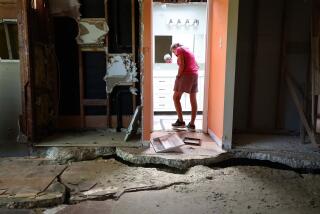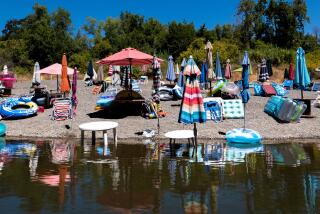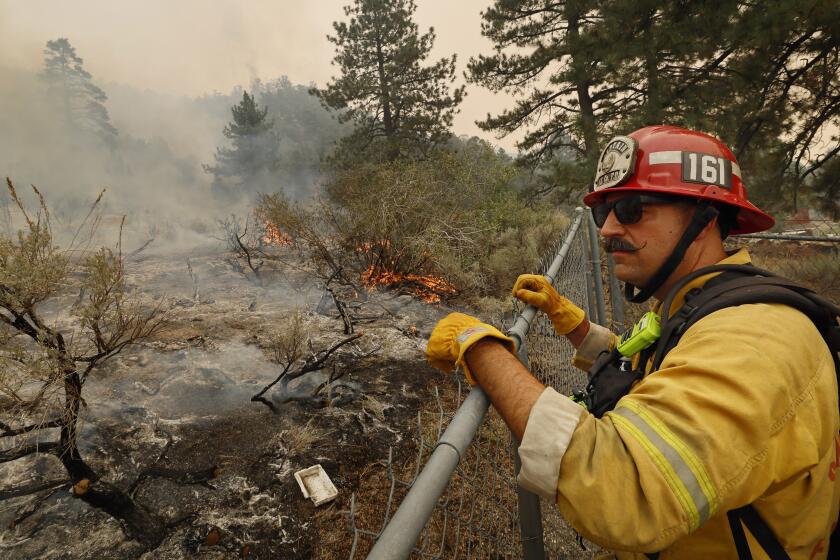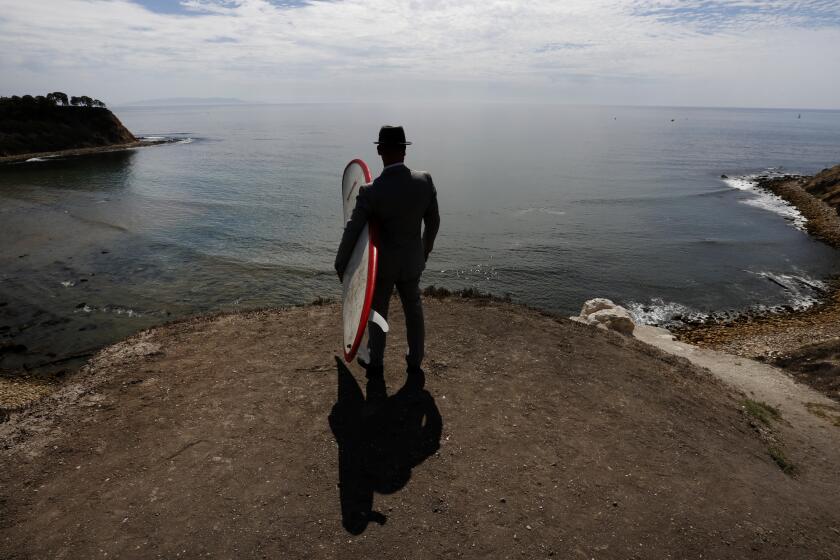ENVIRONMENT SHELLFISH : Mystery, Controversy Surround Sources of Pollution in Lagoon
Like a ghost on a foggy night, an invisible ocean current of effluent steals into the mouth of Carlsbad’s Agua Hedionda Lagoon and swirls into the five acres of shellfish being raised in briny beds.
That’s one suggested solution to the mystery of why high fecal coliform counts--derived from the waste of warm-blooded animals--are found in the commercially grown oysters and mussels that Seafarms West is raising in the shadow of the Encina power plant smokestack.
Another scenario is Rick Graff’s version. Graff, general manager of the Encina sewage plant, said many more logical sources of fecal coliform exist. During rainy seasons, he said, the coliform count rises precipitously in the lagoon as runoff from the area brings with it feces of wild and domestic animals, waste from nearby migrant worker camps and the droppings of sea gulls and other birds.
The plot thickens because water elsewhere in the lagoon, tested routinely by the state Department of Health Services and other regulatory agencies, shows acceptable coliform levels, well within the standards of the National Shellfish Sanitation Program, levels deemed safe for shellfish culture.
“The critical finding of this study is that shellfish not meeting the market standard were taken from waters which do meet the NSSP (National Shellfish Sanitation Program) standards,” a recently released state survey of the lagoon’s coliform pollution stated.
“I’ve watched the (coliform) count rise over the past year or so,” said Dick Glenn, owner-operator of the beleaguered shellfish sea farm. “It’s an early-warning system to alert us to what is happening to our ocean. If something isn’t done now, or soon, it’s inevitable that we will have waters unfit for human contact all up and down this coast.”
Glenn is not the first to sound the alarm about sewage contamination in northern San Diego County’s coastal waters.
Protests by surfers off Cardiff’s beaches about the increasing contamination from a nearby sewage plant outfall preceded Glenn’s warnings, and the results of a nine-month study recently released by the Department of Health Services bore out Glenn’s concerns. State biologists looked at their test data and came to the conclusion that something had to be done to pinpoint the culprit or culprits planting the bacteria in the offshore waters.
Ladon Delaney, executive director of the Regional Water Pollution Control Board, said that he had received the Department of Health Services’ report and that the matter will be taken up by the board.
Patrick Wells, principal author of the report and a veteran of other similar incidents along the California coastline, is convinced that he knows the source of the fecal coliform bacteria upon which the Agua Hedionda shellfish are gorging.
The sources are one or both of the ocean outfalls at sewage treatment plants in Oceanside and Carlsbad, said Wells, an associate public health biologist. The Encina Water Pollution Control Facility outfall to the south of the lagoon mouth and the Oceanside sewer system outfall to the north spew out a combined daily total of 32 million gallons of treated sewage from their underwater snouts.
Despite the sophisticated secondary-treatment systems at both facilities, hardy coliform bacteria survive the process and are carried out into the ocean in freshwater effluent that is diluted when it blends with seawater about a mile from shore.
Encina’s outfall is designed to disperse the sewage effluent far out to sea, where prevailing currents carry it far from coastal shores and surfing areas. To add chlorination-dechlorination equipment at Encina to kill the bacteria before the treated effluent is discharged would be an unnecessary $5-million to $6-million expense, Graff contended.
Barry Martin, who heads the city department operating the Oceanside sewage system, agreed with his Encina counterpart and estimated the cost of installing disinfection equipment at “anywhere from $5 million to $15 million.”
Martin adds that his staff does repeated tests along the Oceanside coastline and around the city’s outfall without finding any high bacterial counts.
Both Martin and Graff question the validity of the state survey’s conclusions and plan to hire experts to defend their contention that their sewage plants are not polluting the lagoon. They argue that they are using proven methods to prevent the type of pollution their systems are suspected of causing.
Wells, who has watched the same defensive scenario develop in Morro Bay, Santa Barbara and Goleta, would like to short-circuit the costly route that the local sewage agencies are taking.
Wells has already read the book. He knows that the agencies will spend thousands of dollars hiring private consultants to prove that their sewage outfalls are not the sources of shellfish pollution. Then, affected shellfish growers will spend thousands of dollars on lawyers to protect their shellfish beds.
That money, Wells said, could be spent more profitably on solving the problem, or, at least, proving who the villain is.
In Morro Bay, after numerous tests and many months of costly studies, the sewer agency was nailed as the offending party and was forced to install a costly disinfection system.
In the Santa Barbara Channel, where Goleta and Santa Barbara sewer systems discharge their treated effluent in outfalls about 10 miles apart, the outcome was the same. Both sewage systems, after many years of controversy, studies and lawsuits, were forced to chlorinate and dechlorinate their treated sewage before pumping it out to sea.
If the two sewage plants opt to detour the expensive route that Morro Bay and Santa Barbara-area agencies pursued, Wells said, they could become the judges and juries of their own fate.
By installing temporary disinfection systems to treat the discharge, Encina and Oceanside could determine whether their systems were affecting the shellfish in Agua Hedionda Lagoon. If, after disinfection systems were installed, the shellfish coliform count diminished, then the systems would have convicted themselves as the source of the contamination.
More to Read
Sign up for Essential California
The most important California stories and recommendations in your inbox every morning.
You may occasionally receive promotional content from the Los Angeles Times.










